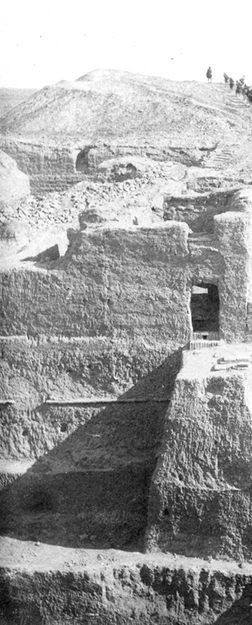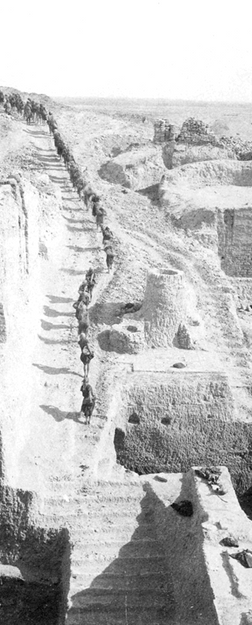The extant documentation, as far as known to us, pertaining to the excavations carried out by the University of Pennsylvania at Nippur in the years 1889-1900 as a searchable data base.
WORK IN PROGRESS
Introduction
The purpose of this publication is to make available as a searchable data base digital transcripts of the copious but so far unpublished and practically inaccessible written and photographic records from the four archaeological expeditions of the University of Pennsylvania to Nippur in 1889-1900 and the events before and after them for anyone wishing to work on any aspect of those excavations. In this way, we hope that the results of the excavations at Nippur will be saved from oblivion, and that the considerable outlays by the private gentlemen who back then financed the expeditions, not to mention the labors of the excavators themselves, will finally bear fruit.
As ever when a large body of original source material is made available, this publication is relevant to several lines of research: archeology; history of scholarship; and ethnography. To varying extents, it will be possible –
- to study the archaeology of a major Babylonian city, from the fourth millennium B.C. to the eighth century A.D.;
- to establish the archaeological context of some of the thousands of cuneiform tablets and other objects excavated at Nippur, hitherto routinely regarded as having no such pedigree;
- to establish the topography of Nippur during the ages;
- to illustrate the pursuit of knowledge in the late 19th century West;
- to elucidate the state of American archaeology in the late 19th century;
- to elucidate the social status of humanistic Western scholars in the late 19th century;
- to study the working conditions of a Western archaeological expedition in the Ottoman Empire;
- to study the life and customs of the rural Iraqi population under Ottoman rule
- to study the personal accounts of the brave participants of the excavations and their experience living and even dying on an excavation site in a deserted and hostile area.
Furthermore, the publication of the archeological results of these old excavations at Nippur may serve as a guide for future excavations at the site. And we hope that, with the publication of the original sources, the current prejudices against the 19th century explorers as glorified treasure hunters or mere stooges of Western colonialism may be softened somewhat. In due course, we plan to write two books, based on these materials: one digesting the archeological results in the light of present knowledge, and one giving a history of the four expeditions as set against their general cultural background. But this should not prevent anyone from writing on those subjects.
The original sources published here are today scattered in many places. The following are the main repositories with their respective sigla:
UPMAA
The University of Philadelphia Museum of Archaeology and Anthropology. This Museum of course preserves huge archives about its many undertakings since its foundation in 1887, of which the Nippur archives are but a part. The Museum plans to publish scans of all its archives; but this will take many years.
HSN
Hilprechts schriftlicher Nachlass, since 1933 in the archives of the Hilprecht-Sammlung, University of Jena. The entire archive has been scanned and is accessible at https://hilprecht.mpiwg-berlin.mpg.de
HCL
Haverford College Library. This includes the original of the first part of Meyer’s diary for his stay at Nippur in 1894, though how it got there is obscure. Scans of the original have been published http://triptych.brynmawr.edu/cdm/compoundobject/collection/HC_DigReq/id/19210
FAL
Fine Arts Library, Harvard University, Haynes Archive.
BS
Dossier Edhem Eldem. Hilprecht’s letters to Halil Edhem, known to us from scans kindly supplied by Dr. Bernhard Schneider, who in turn received them from Halil Edhem’s descendant, Edhem Eldem.
Doubtless more relevant archives exist. Please let us know if you find one. One archive, to which we haven’t yet had access, is that of the Istanbul Museums.
The present edition. – We have arranged the documents in six groups: one for each of the four expeditions to Nippur, one for the financial records for all four expeditions, and one for what happened to the finds and the excavators after the excavations were over – mainly registration in the Museums, publication, recriminations, etc. This last we call Aftermath.
Within each of these groups, a further subdivision has been made between records, correspondence, and newspaper clippings. “Records” include notebooks and diaries, such as catalogues of finds; reports from the field; minutes of meetings, etc. Naturally, it is not always easy to distinguish “Records” from “Correspondence”. For instance, Haynes’ reports during the III Exp., first to Peters, then to E.W. Clark, are technically letters to the two gentlemen, yet “Haynes’ Babylonian letters,” as the Committee dubbed them, were understood by all to be reports to the Committee as a whole.
Within each section, the documents are arranged in strict chronological order. The caption for a document looks like, for instance, “1890-06-12,” meaning “June 12, 1890.” Occasionally, this has made an arbitrary or even fictitious date assignment necessary. Undated letters are assigned a date to year, usually based on contents, leaving month and day unstated, and the caption will then be, for instance, “1890-00-00.” Documents covering a longer period, as the notebooks and diaries obviously do, have as a rule been assigned to the expedition during which they were written. The caption will then be, for instance, “I Exp., Peters, Journal of Excavations”.
Our edition of these documents tries to reproduce the documents as closely to the originals as possible, including errors in spelling and punctuation. In a few documents, an editorial rearrangement was deemed necessary [Hilprecht’s Archaeologische Funde, Meyer’s Diary, etc.]. As a rule, the pagination of the originals has been ignored; otherwise, the page number is indicated in the margin next to the line in the transcript where the transition from one page to the next in the original takes place. Our editorial comments and other metatext are added in italics. They include cross-references between documents and the identifications of objects mentioned in the records with their present museum registration numbers. When one or more letters in a word, or an entire word has been omitted in what we believe is unintended neglect, we supply the missing parts in italics. Words in blue are of doubtful reading.
Each document is provided with a heading conveying the following information:
- Date of the document when known
- Name of author, or in case of correspondence, names of the correspondents. When the name of the author or the recipient is not known, “unknown” takes that place.
- Present location of the document, plus archival location.
- The catalogue numbers in Legrain’s 1926-1931 register of the Philadelphia archive (given as “L-number”), or other relevant information.
- Status of the original – hand-written or typed original (including carbon copy), or typed copy of an original. We have included the latter only when no original is extant – which unfortunately is more often the case than little children might have desired.
For the abbreviations used in the headings, please consult the List of Abbreviations, p. 000.
Scope of the documentation. – We have included practically everything in the above archives, even if much of the material is not directly relevant to the excavations and their results. We omitted only typed copies of extant hand-written originals and quite informal jottings containing information available elsewhere. We also excluded a large part of the HSN archive that has nothing to do with Nippur, such as Hilprecht’s notebooks or sermons from his student days, or his correspondence with other scholars, or the extensive correspondence of the family of Hilprecht’s second wife, Sallie Crozer, some of it from way before her marriage to Hilprecht. Even so, some might think that in casting our net so broadly, we have seriously diluted the information contained in the records. But we have endeavoured to tell the fantastic saga that was the Nippur expeditions as far and as fully as possible in the participants’ own words, and to present their very different personalities as best we can. After all, these personalities and their various idiosyncrasies had a decisive impact on the outcome of their work.
We owe an enormous debt of gratitude to many different people, first and foremost to Dr. Alessandro Pezzati, Senior Archivist at the University Museum, Philadelphia, who not only permitted us to publish the Nippur records under his care but actively supported the project through the years, providing us with scans and rescans of documents whenever necessary. Prof. Manfred Krebernik of the Hilprecht-Sammlung, University of Jena, likewise allowed us to utilize the Hilprecht papers and provided us with scans of the entire archive well ahead of its publication. Dr. Bernhard Schneider, University of Innsbruck, who has worked extensively on the same Nippur records, freely shared his archaeological knowledge and results on the Ekur Temple with us and provided the scans of Hilprecht’s letters to Halil Edhem. Sarah Horowitz, Curator of Rare Books and Manuscripts at Haverford College Library, supplied us with scans of the lamented Joseph A. Meyer’s diary. Joanne Bloom, of the Fine Arts Library, Harvard University, gave us access to the Haynes Archive housed there. Prof. Christine Harrauer, of the University of Vienna, liberally gave of her time to assist us in deciphering Hilprecht’s oftentime difficult handwriting in his diaries. Prof. Alessandro Gori, of the University of Copenhagen, kindly transliterated and translated the documents written in Arabic and Ottoman Turkish. Our most quantifiable debt of gratitude is to the Shelby White and Leon Levy Program for Archaeological Publications at the Harvard Semitic Museum which supported our project financially through three years, and to its Assistant Program Coordinator, Dr. Peter Mueller, who followed the project with keen interest and worked hard to overcome bureaucratic hurdles in both America and Denmark.
Further planned metatext:
Chronology of the excavations
Register of persons, places, and technical terms
Bibliography of the Expedition

